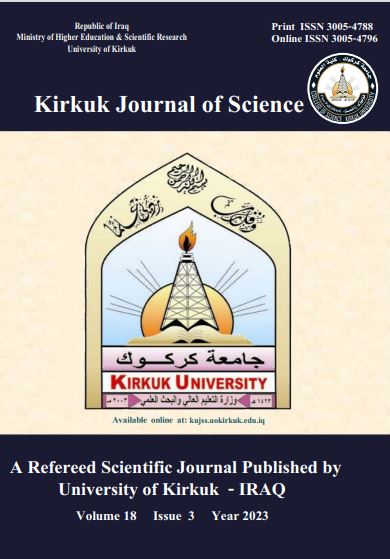Abstract
The aim of this research is to improve the flow properties of polymers,
in particular viscosity, by mixing polymers to be used in various fields.
Samples prepared by stirring polyvinyl alcohol on fire for half a second
in a fixed weight ratio with divergent weight ratios of polyethylene
glycol and polyvinylpyrrolidone, both separately. Other samples were
prepared in the same way by mixing the three polymers followed by
measuring the molecular weight of all the samples. This method of
preparation made the polymers insoluble in water, therefore nitric acid
was used to dissolve them. Flow time of the solvent and all solutions
were measured, which was used to calculate the viscosities, It has been
shown that these viscosities increase with increasing concentrations of
polymers in solutions by establishing a positive relationship between
them, It was found that the intrinsic viscosity decreases with increasing
concentrations after being graphed using intrinsic viscosity calculations
from the relationship between specific viscosity and relative viscosity
logogram with concentration. These results may be used in industrial
medical applications as well as scientific studies.
in particular viscosity, by mixing polymers to be used in various fields.
Samples prepared by stirring polyvinyl alcohol on fire for half a second
in a fixed weight ratio with divergent weight ratios of polyethylene
glycol and polyvinylpyrrolidone, both separately. Other samples were
prepared in the same way by mixing the three polymers followed by
measuring the molecular weight of all the samples. This method of
preparation made the polymers insoluble in water, therefore nitric acid
was used to dissolve them. Flow time of the solvent and all solutions
were measured, which was used to calculate the viscosities, It has been
shown that these viscosities increase with increasing concentrations of
polymers in solutions by establishing a positive relationship between
them, It was found that the intrinsic viscosity decreases with increasing
concentrations after being graphed using intrinsic viscosity calculations
from the relationship between specific viscosity and relative viscosity
logogram with concentration. These results may be used in industrial
medical applications as well as scientific studies.
Keywords
Viscosity; Polyvinyl alcohol; Polyvinylpyrrolidone; Polyethylene glycol.
Abstract
الهدف من هذا البحث هو تحسین خواص تدفق البولیمرات وخاصة اللزوجة وذلک بخلط البولیمرات لاستخدامها فی مختلف المجالات وقد تم استخدام عینات من کحول البولی فینیل والبولی ایثیلین جلایکول والبولی فینیل بیرولیدون والتی تم تحضیرها عن طریق تحریک کحول البولی فینیل على النار لمدة نصف ثانیة بنسبة وزنیة ثابتة مع نسب أوزن مختلفة من البولی إیثیلین جلایکول والبولی فینیل بیرولیدون ، کلاهما منفصلین، وحضرت عینات أخرى بنفس الطریقة عن طریق خلط البولیمرات الثلاثة وتم قیاس الوزن الجزیئی لجمیع العینات. طریقة التحضیر هذه جعلت البولیمرات غیر قابلة للذوبان فی الماء ، لذلک أذیبت فی حمض النیتریک. تم قیاس وقت تدفق المذیب وأوقات تدفق جمیع المحالیل ، والتی تم استخدامها لحساب اللزوجة النسبیة (ƞre) ، حیث استخدمت لحساب اللزوجة المحددة (ƞsp) ، واللزوجة المنخفضة (ƞred)، واللزوجة المتأصلة (ƞinh). تبین أن هذه اللزوجة تزداد مع زیادة ترکیزات البولیمرات فی المحالیل عن طریق إنشاء علاقة إیجابیة بینها ، بینما تنخفض اللزوجة الجوهریة مع زیادة الترکیزات التی حسبت من العلاقة بین اللزوجة المحددة و لوغریثم اللزوجة النسبیة ورسمت مع الترکیز. یمکن استخدام هذه النتائج فی التطبیقات الصناعیة والتطبیقات الطبیة والدراسات العلمیة.
Keywords
البولی ایثیلین جلایکول
اللزوجة
بولی فینیل بیرولیدون
کحول بولی فینیل
